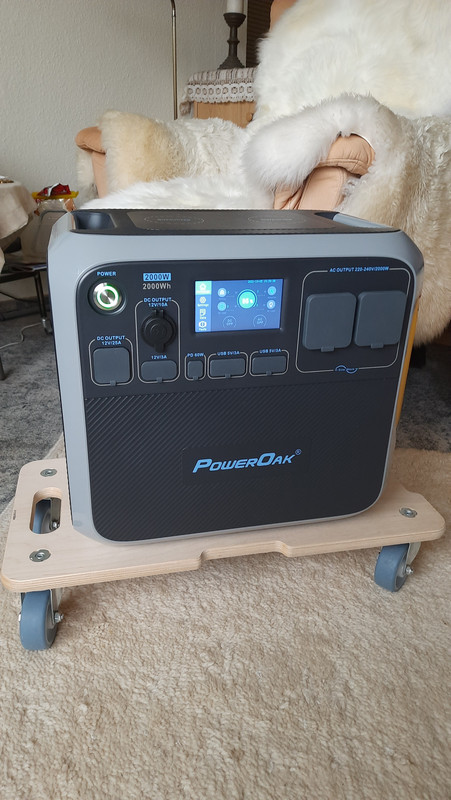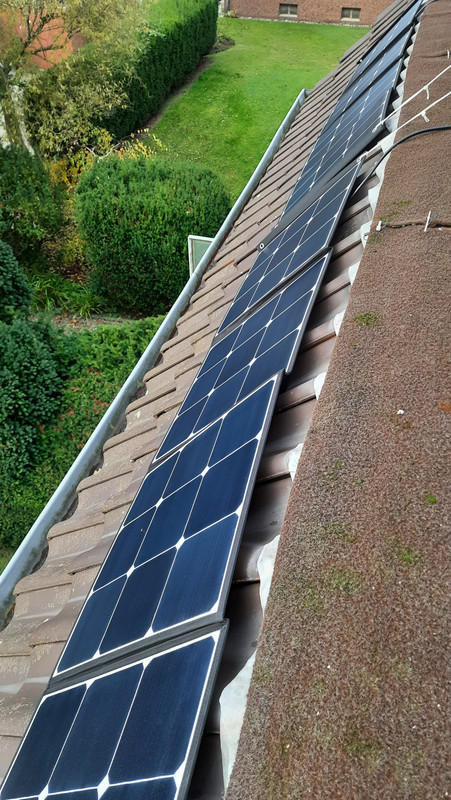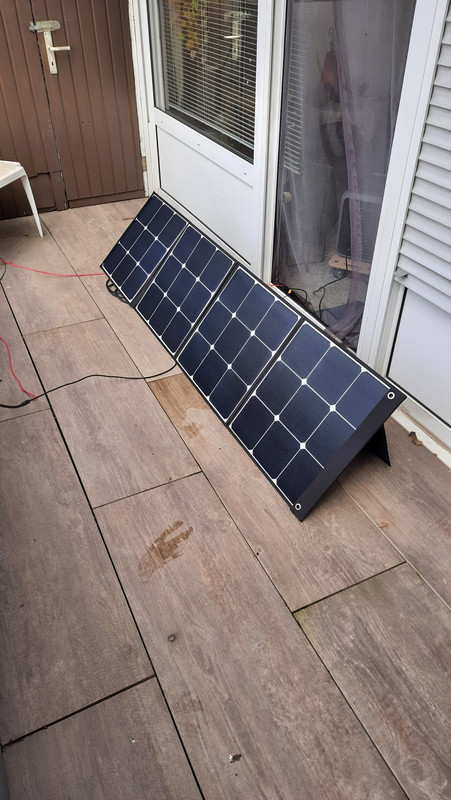
|
|
SUBSIM: The Web's #1 resource for all submarine & naval simulations since 1997
 |
SUBSIM: The Web's #1 resource for all submarine & naval simulations since 1997 |
 09-28-21, 11:38 AM
09-28-21, 11:38 AM
|
#1 |
|
Soaring
|
They have become popular in recent two or three years, solar panels that either feed into the existing power cable structure of the house or appartement (and need licensing by the power supplier, and many in Germany say No), you just have to plug them into a usual power wallmount like a radio, and the electricity flows into the cables in the wall and supplies all your wallmounts), or you charge a battery device of any sorts.
Often such batteries are usual car batteries, at least it is possible. I know about the limits of chraging with sun power in winter, and even in summer on a blue sky day you ight get just 7 hours time out of it. But how much is to be expected of these things, can you maintain a refirgerator with these, a TV and maybe one or two light bulb? Charging devices for smartphones and tablets (which will be of no use of the radio towers are not electirclaly supplied, I klnow I know...)? I have a small solar thing that is enoiugh to slowly charge a mobile powerpack as to be sued for smartphones, lets say 20mmm mAh. But the purpose I outlined? There is space for 2-3 panels, sizes of maybe 100x150 on my balcony. I plan to get involved in this, but this is definetly new terrain for me, and I lack the electric knowledge basics. Also, many such sets have batteries that indeed only offer two poles, but no plugions for housold plugs or USB or anything. Car batteries. Obviously a hardware interface is needed to make these batteries's energy accessible. Well, I am standing there, clueless a bit. Anyone with experience or advice on all this? costs can be up to lets say 2000 Euros, but the stuff must be "mobile", to be set up only when indeed needed.
__________________
If you feel nuts, consult an expert. |

|

|
 09-28-21, 12:05 PM
09-28-21, 12:05 PM
|
#2 |
|
CINC Pacific Fleet
 |
A little lesson in electricity
Ohms first law U=IXR Where U is voltage Where I is currency Ampere Where R is resistance Ω But you need to know the effect P. So First effect law P=UXI. Where P is effect Watt This was todays lesson Edit Got a business idea. Don't know how to explain it. It's solarpanel glued onto soft plastic and then rolled up and placed on the top of the roof. When it's sunny this solarpanel is unrolled and you charge your batteries you have in your basement End edit Markus
__________________
 My little lovely female cat Last edited by mapuc; 09-28-21 at 12:16 PM. |

|

|
 09-28-21, 12:21 PM
09-28-21, 12:21 PM
|
#3 |
|
Shark above Space Chicken
|
I have no idea about power where you live but connecting alternate power sources to your house requires some sort of switching for safety. If you have a gas generator large enough to power the house you would need to disconnect from the power grid before tying in the generator, or have an expensive transfer switch arrangement that handles that automatically. It's needed to handle phase problems etc.
I simply unplug my fridge from the wall and into an extension cord from the little generator running outside when needed. Solar panel systems also use some type of transfer switching arrangement but I don't know how those work.
__________________
 "However vast the darkness, we must provide our own light." Stanley Kubrick "Tomorrow belongs to those who can hear it coming." David Bowie |

|

|
 09-28-21, 01:24 PM
09-28-21, 01:24 PM
|
#4 |
|
In the Brig
 |
Im not certain how one connects a solar panel to household supply.
But I have used them on a sailboat. For strictly 12 volt system lights and appliance . Add up the total number of amps you will be using and for how long each day. This determines the minimum wattage of the solar panel required and the size of your battery bank. We added two 185 watt panels to our 600 amp hour battery bank and we never lacked. It powered our propane refrigerator, propane heaters and stove, navigation equipment, RADAR, radios, lights. More than we needed. To run household appliances such as coffee makers, blenders, etc etc you only need a modified sine wave inverter. But for sensitive electronics like TV’s PC’s you should invest in a true sine wave inverter. Which every inverter you choose either one will place a massive drain on the 12 volt battery bank and charging system. So TV and PC are not something which can be run regularly. Unless you have a lot sunshine and many many more panels. Then there is the the issue with batteries. Car batteries won’t do, you need a Deep Cycle battery and they all to some degree vent explosive gas when being charged. So good ventilation is a must. That’s all I can think of right now. |

|

|
 09-28-21, 02:07 PM
09-28-21, 02:07 PM
|
#5 |
|
Soaring
|
There are startups, from austria for exmaple, where the panels get connected to some directioning device or inverter, and that device gets linked to a battery/storage and gets plugged into a usual wall mount already existing everywhere in the apprtment/house, a usual wallmount where you usually get electricity out off, you have your TV and PC connected to it for exmaple. But here, the direction gets reversed, you do not drain power from the wallmount, but you stuff it into the walmount, from the solarpanel and inverting device and battery into the circuit of your house cable circuit, and then you have it available at other wallmounts on the same circuit. Its a plug and play solution, and is simple to attach indeed, you have the panels placed, connected to the inverter or what the device is, the device goes to a battery, the battery to a wallmount, and thats it.
I did not believe it, too, until i read about it this weekend. Question is whether the economic usabilitiy and the costs for especially the battery, calculate well. I look for something smaller, maybe. I have no electric heating and electric hot water, am more interested in beign able to reliably recharge batteries, maybe run a refrigerator, or just a light bulb or two. So I more likely am looking for a setup like this: solar panel to a cable-connected mobile battery with inbuild inverter (if that is how its called, I am not sure, the German word is I think Wechselrichter), and some mounts in it for various plugs.   In Austria you can feed back 500W into a wallmount and circuit legally, in Germany 600, and an EU norm even mentions 800W. However, in this case you need to repalce your electric meter if it is a Ferraris meter with rotating disk in the display, becasue that disc would start to rotate in opposite direction if the solar device/batter starts to feed into your circuit. Since these solutions due to thew battery are already a bit expensive (2000-3500 Euro), the costs mount up if you want to replace the electric meter as well. For Germany: https://machdeinenstrom.de/sind-mini...ftwerke-legal/
__________________
If you feel nuts, consult an expert. Last edited by Skybird; 09-28-21 at 02:24 PM. |

|

|
 09-28-21, 03:00 PM
09-28-21, 03:00 PM
|
#6 |
|
CINC Pacific Fleet
 |
I would recommend you to buy a battery with a higher capacity, well buy a couple when you're at it.
It's not how many watts you put into the wall socket it's all about voltage-In Europe it's between 220-240 V. Your inverter(=Spannungswandler) should have this as output. Markus
__________________
 My little lovely female cat |

|

|
 09-28-21, 03:42 PM
09-28-21, 03:42 PM
|
#7 |
|
Soaring
|
From my ebike battery I know that the storage capacity is measured in either Wh, or Ah.
1Wh = 1Ah x 1V My Bosch powerpacks for the bike for example have 500 Wh each, at their output of 36V that means they have 13.9 Ah. If the batteries would have an output of 12V, it would be 41.7 Ah. Its not enough to know how much "load" a battery can hold, you need to also know at what power (V) the consumer is running. With solar panels, their specs influence how much energy they create at a given sunshine level, and over what time. Obviously this decides how fast the battery creates a charge. I do not want to go for a solution that feeds into the existing wallmounted circuit. A battery that can support one or two light bulbs or a ventilator directly, occasionally a recharging of powerbanks or mobile devices, and maybe run a refrigerator via cable extension, would be good enough. I am not planning to go eco power here, I want a backup solution as part of my prepping for emergency situations. The threat of blackouts is somethign that in all secrecy is starting to worry even German authorities, it is rumoured. A blackout of just an afternoon, that is one thing. A blackout lasting for several days - that is something very different due to the long lasting aftermath from that: could easily become weeks. Therefore, i have started to check and resupply my supplies of everything, and have increased my stocks of drinking water. I also have gotten sacks of charcoal and wood for my rocket oven, for cooking Running an electric heater I have ruled out, since I think that is a hopeless task with such batteries. When do you heat? In winter. And what do you not have in winter? Plenty of sunshine.
__________________
If you feel nuts, consult an expert. Last edited by Skybird; 09-28-21 at 03:50 PM. |

|

|
 09-28-21, 04:14 PM
09-28-21, 04:14 PM
|
#8 |
|
In the Brig
 |
So if remembers correctly, a 800 watt inverter divided by 240 euro volts would provide 3.3 amps. Then we reduced that by 10% because of connections, length of wire runs and other mysteries. This gives you an idea what can be powered.
Say you use a 12volt deep cycle battery with a 105 Amp Hour rating. Which means your battery will be as dead as a door nail in 105 hours at 1 amp per hour. To determine the minimum drain on your battery the inverter causes when pushing 3.3 amps (full output). Take 800w divided by 12 volts and that inverter is drawing a minimum of 66 amps an hour. Something like that will only give you a little over an hour of use at full output before your battery dies. Two 400 watt solar panels and a lot of clear sunny days ought to keep things going quite nicely. If it’s a 24 volt battery it gets better. At least I think so, I could be wrong I haven’t had to mess with 12 volt stuff and inverters for 20 plus years |

|

|
 09-28-21, 04:57 PM
09-28-21, 04:57 PM
|
#9 |
|
Soaring
|
Thanks for showing me my huge deficits...

__________________
If you feel nuts, consult an expert. |

|

|
 09-28-21, 05:41 PM
09-28-21, 05:41 PM
|
#10 |
|
Fleet Admiral
 |
The Frau invited a Solar salesman over to our house. Yikes!, what a sales job. He was actually pretty good at the sales talk.
But there was only one definite number in all his calculations. $36,000 to have his company install it.    The best way to get solar for your house is to buy a house that already has it installed where the seller has already taken several baths on the "investment" $36K and we live in a small triplex! That was a big bowl of Nope with extra Nope sauce on the side.
__________________
abusus non tollit usum - A right should NOT be withheld from people on the basis that some tend to abuse that right. |

|

|
 09-29-21, 07:06 AM
09-29-21, 07:06 AM
|
#11 |
|
Grey Wolf
 Join Date: Sep 2011
Posts: 979
Downloads: 256
Uploads: 0
|
If you're allowed to feed power into the wall, how do you prevent islanding in the event of a loss of power where the utility service is off due to a storm, fault, etc., and you are feeding power into the grid resulting in the possibility of electrocuting utility workers?
Why would you need to replace a rotating disk meter? If it's spinning backwards, you are feeding the grid and should pay less for electric service. Does this system account for the differences in real, apparent, or reactive power? |

|

|
 09-29-21, 07:41 AM
09-29-21, 07:41 AM
|
#12 | ||||
|
Soaring
|
Quote:
Quote:
Whether this makes economic sense, I canot say, the battery especially is expensive, and I do not understand how much charge it holds and what it can do, and how relaistic it is to get it charged on lets say an average autumn day. The full system by EET imo is expensive, I find it difficult to imagine it does compensate for these costs by saved energy from your provider. But I might be wrong, I just dont know. Its also not my interest. I want an emergency backup for the most urgent tasks durign a lastign blackout, so no feedback into the powergrid, but the solar panel directly loading a battery with power sockets in it where I can attach powerbanks, mobile CPUs, lightbulbs, at best a refrigerator, since this does not run constantly. Quote:
Check here (English): https://www.eet.energy/en/ From their advertising: Quote:
__________________
If you feel nuts, consult an expert. Last edited by Skybird; 09-29-21 at 07:51 AM. |
||||

|

|
 10-28-21, 06:40 PM
10-28-21, 06:40 PM
|
#13 |
|
Soaring
|
https://www.bluettipower.eu/products...-power-station
I am in the process of getting engaged with a solar power generator unit of ~ 2000 Wh and three solar panels 200W each, meant normally for mobile vanlife. I have no van, but am stationary, and that is fine due to the weight of the thing, almost 30kg wihtout the 3 panels (6kg each). Battery and all input and output mounts and options, of which there are plenty, are all inbuild, I do not need to feed into the house-mounted circuit. My only hesitation comes from the price for this - apparently top quality set, its 3500 coins (currently a sale for 3200), and my wondering whether I maybe might be better off with two 1000 WH units, weighing just 10 kg, and thus beign able to have one in use and carrying it aroung while the other is played outside and hangs on the panels and gets charged. The mentioned set would charge the battery on a fully sunny day in 5-6 hours, so on grey winter days it will last several times as long, no doubt, and due to the short days: several days. Its not about keeping the TV running, but to be able to rechgarged the many AA and aAA batteries, and gadgets, a slo my bicycle batteries, and having the option to heat a cup of water over the day repeatedly and running two or three low watts LEd lightbiulbs in the dark. Emergency situations in case of a days-long blackout. But then i wonder if these things in such a scenario really would be my primary concerns. Also, having solar panels hanging around on the roof and loggia could attract unwanted attention by plunderers. I am undecided, and I do not like to stay in this state, I use to consider things, and then decide, but this one has kind of paralysed me since weeks now. It gets annoying, and I cannot recognise myself. Did any of you take action over getting generators or solar installations or anythign to prep for scenarios involving lasting loss of electricity? AA and AAA batteries, of ourse you stockpile them for prepping, candles as well, to keep radios, tochlights and so forth operatioanl. But generator-scaled stuff as I reason about here? A typical good bicycle battery today has 500-650 Wh, btw. The set I think about offers three times that capacity. The cost-effect ratio to me looks suspicious. Thats why I am so hesitent. Noisy gas-driven generators needing stockpiles of fuel and such stuff are out of the question due to my living situation in my place. If I go with such a system, it must be solar, for whatever its worth or not worth.
__________________
If you feel nuts, consult an expert. |

|

|
 10-29-21, 09:45 AM
10-29-21, 09:45 AM
|
#14 |
|
Soaring
|
The stalemate had to be ended either way, I was becoming angry about myself.
I ordered the Bluetti / PowerOak AC200P and 3x 200W solar panels for 3200 coins. Possible that I will need cable extensions, which should not be a problem. Having a loggia in the oblique roof, I can lay out the three solar pads (2,0 x 0.5 m each) on the roof tiles if needed and have them close to a good angle towards the sun. Its the west side, fully sunlight hit he panels from early noon time on. I plan connection cables holes to be drilled through the (wooden) sidewall, so that the unit can stay inside my flat even when beign attached to the panels. The panels are mobile, can be folded to bags 50x50 cm, 6 kg each. My solar setup options are not totally ideal, but solid, I estimate. And in the case of cases I could use a meters-long extension cable and set the panels up in the backyard garden two floors below me. I will post experiences with solar charging in these autumn and winter season conditons. It might be of interest for others, too. BTW, no Li-ion battery (danger of fire), but a LiFePO battery. Very durable: minimum 3500 charging-rechargign cycles. It can be charged via solar panels, wallmount, parallel with both (2.5 hours only!), generators, and via car batteries without needing inverters or any additonal equivalent (due to 12V in cars). Simultaneously consuming and charging is possible, too. 13 discharging options and connection mounts. The versatility is already inbuild, and I think that was an important point for me, it reduces the chance for falling victim to bad surprises. The only setback: its not truely fully outdoor/weatherproof, the battery must be protected. I know it, and assessed it, and decided its not decisive for me. The thing weighs 27 kg anyway, so you do not carry it around. Plus 18 kg solar panels.
__________________
If you feel nuts, consult an expert. Last edited by Skybird; 10-30-21 at 08:48 PM. |

|

|
 11-05-21, 11:23 AM
11-05-21, 11:23 AM
|
#15 |
|
Soaring
|
The system is complete, and I had first test runs yesterday and today. All works. And better than I expected.
The battery has 2000 Wh. The solar panels are three, each 200W, so that is a maximum capacity of 600W on a fine clear sunny summer day. Each panel has 20V. The battery demands charging currents between 35V and 150V. So you can charge with 2 or 3 of these panels, but not with just one. The way I did it, is expensive. You can get the same effect, I assume, when buying components individually and then assemble everything by hand. But for that you really need to know what you are doing, and you need to have some background knowledge about electronics and their components. I don'tT know much more about it than school physics, and much of that already is forgotten by now. This set however is the all-inclusive solution, fail-safe and guaranteed compatible. I put things together without even looking for a manual. Its no candidate for a setup beauty contest, just a quick functionality test. Now that I have sorted the sequence of steps, I can set it all up and put it together again in 5 minutes.  27kg, with packing material it was 34 kg.  3 of these. 6.5 kg per item. Folded 52x52cm, unfolded 52x220cm. General idea of how to arrange them on my balcony/loggia:   Now, today was grey and overcast sky, with only a few sunbeams coming through for some seconds here and there. Lousy conditions for photovoltaic experiments.  I expected to get not more than 5-10% of the possible maximum (600W) under ideal conditions. And it was like that, I got charging with 10-30W with all 3 panels. I was not disappointed, I expected that. As I said: lousy sky. But then... I remembered to have red that for some reason that I do not know a single panel laying in shadow can nevertheless have a dramatic degrading effect on the efficiency of the other panels as well, even if the latter are in non-shadowed conditions. The one panel on the ground was partially shadowed by the wall of the balcony, maybe 30-40% of it covered. I decided to have an experiment. I took the one panel on the ground out of the setup, and ran with just the two on the roof, fully exposed to the grey ceiling. IMMEDIATELY the charging jumped upwards to unbelievable 150-190W! that was a quarter and almost half of their full capacity (2x200W)! Lesson learned: never have even just one panel laying in the shades. The difference is multiple factors. This I did not expect. How will it be in better conditions, or in summer, and then with all three panels? Will everything go up in flames here? Will I still be there to report? Test passed. With flying colours. P.S. This is a setup meant to be mobile, it is not fully weather proof. It is not intended to be left in place for weeks and months. For a mobile panel, it is sturdy and robust of very good quality, however. It will survivi a mild rain of limited duration, but it should be avoided if possible. The battery shuts down at temps below 0. So having it installed in your camper van while visiting Scandinavia in winter will not work well. And it certainly is too heavy to be carried around int he woods. For my needs, however, it is a perfect, an absolutely perfect solution. I bought in a sale, paid a bit over 3000 coins, but got one panel for free, almost. Happy guy I am!
__________________
If you feel nuts, consult an expert. Last edited by Skybird; 11-05-21 at 11:35 AM. |

|

|
 |
|
|
